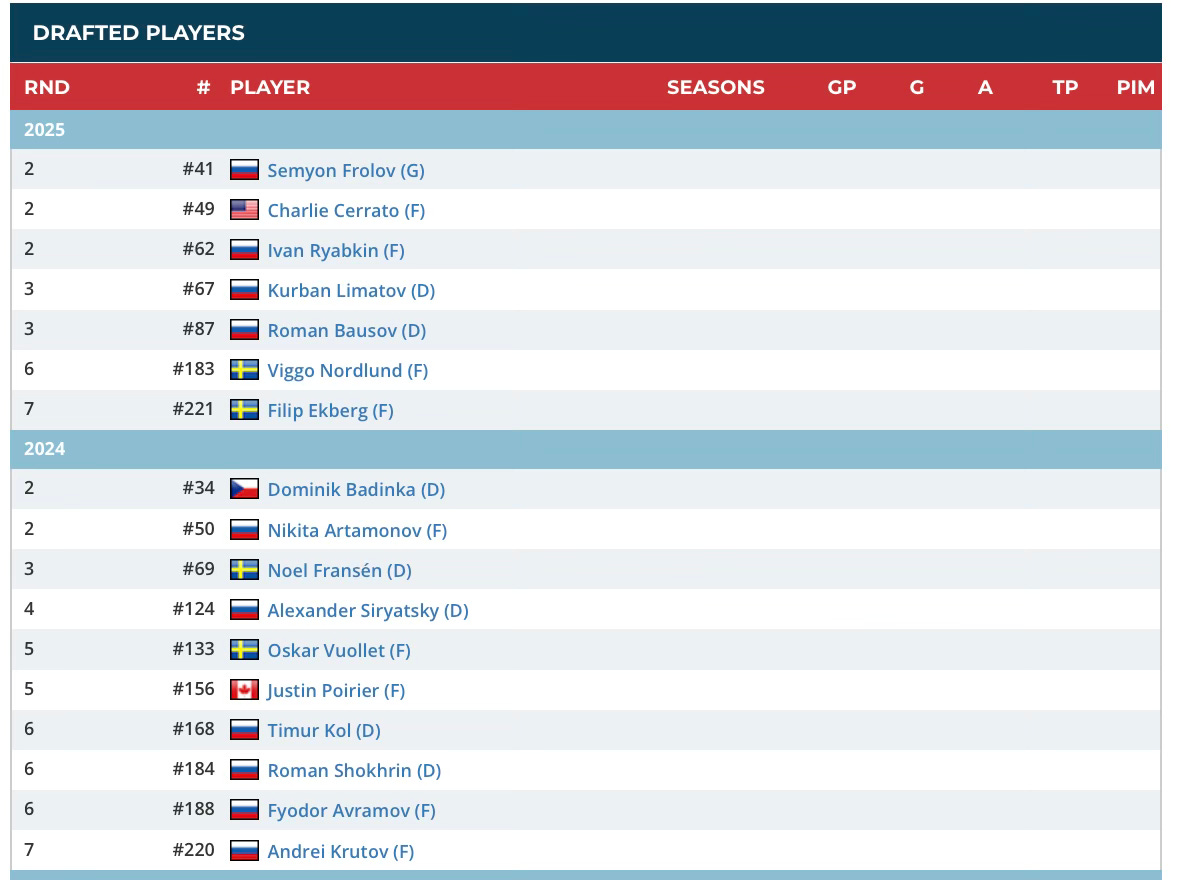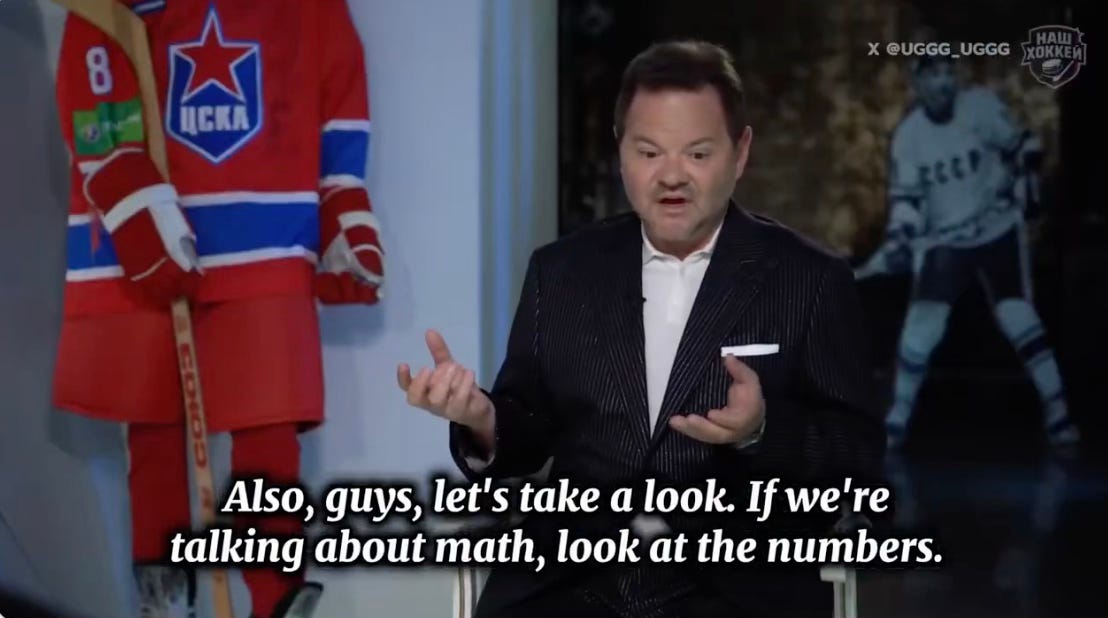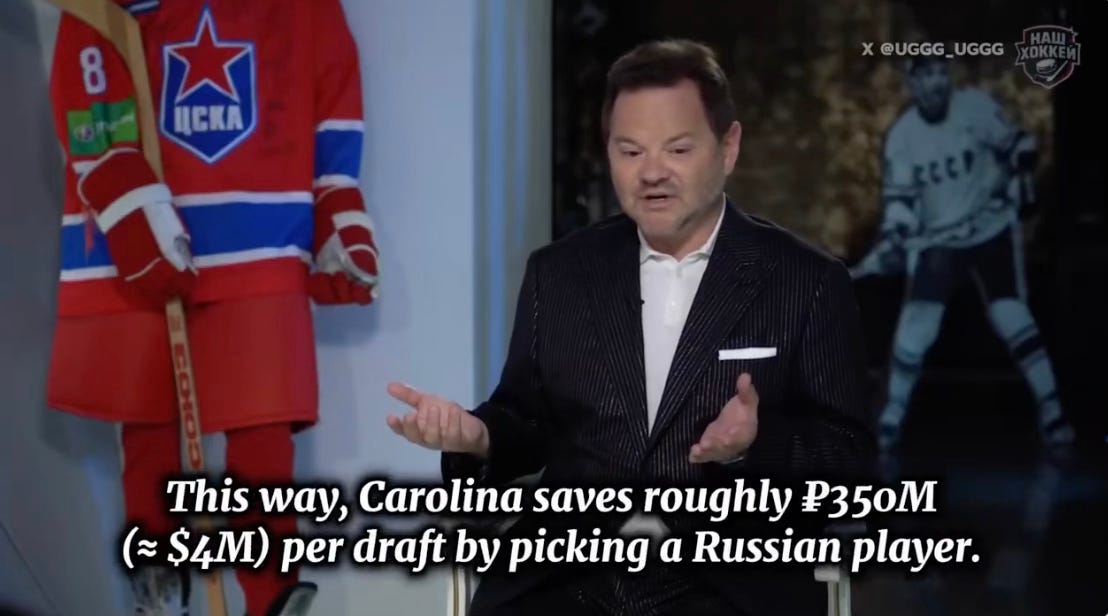Why do the Carolina Hurricanes draft so many Russians?
This somehow connects to the Dallas Cowboys QB strategy, somehow...
This is one of those scatter-shooting pieces, bear with me, and maybe we’ll get somewhere.
Normally this would be one of my busier weeks, my unofficial summer kick-off to in-person hockey coverage.
Unfortunately for me, the World Junior Summer Showcase isn’t being held in Plymouth, Michigan this year and instead is being held in Minneapolis, to better align with the actual World Junior Championship that starts in December1.
As a nice consolation prize, there will be live high-level hockey at USA Hockey Arena next week when the Plymouth hosts the 2025 Under-17 World Nations, an early look at prospects for the 2027 and 2028 NHL Draft.
If you are a reader in the Michigan area, and need that hockey fix, here is the schedule. Feel free to find me and say hello.
OK, that’s next week. In the meantime, today, I’d like to talk about the NHL Draft and trying to maximize value.
This wormhole actually started yesterday morning while reading my pal Bob Sturm’s piece on Dallas Cowboys back-up quarterback Joe Milton.
If you don’t care for the Cowboys, which is fine, this part is what stuck out to me when Bob started discussing how the NFL franchise approaches drafting quarterbacks.
There was little investment in this spot, even though it is the biggest lottery ticket purchase any franchise could ever search for. In other words, if the smartest football theory was put into practice, a franchise would literally spend a draft pick per year on this position.
Dallas has never really thought that way. Since the Tony Romo era began roughly 20 years ago, the Cowboys have drafted just four QBs and zero in the Top 100 of the draft.
The NFL and NHL Draft isn’t apples-to-apples, in fact it’s more like comparing coconuts and tomatoes — both technically fruits, but no one would accuse them of being similar.
The NFL Draft is a “what can you do for me now?” process, players jump into the league right away and later-round draft picks are expected to be on the roster immediately.
The NHL Draft is more of a long-term gamble, a small percentage ever make it even to pro hockey, and with how much scouting has improved across the board, hidden gems beyond the third round have become close to obsolete.
It’s why, if I were running an NHL team, I’d probably use all of my draft picks after the fourth round on goaltenders. Compare it to Bob’s QB strategy in the NFL, it’s one of the most valuable positions in all of sports, why don’t you load up on at least a couple lottery tickets for a position of high variance?
OK, getting back to the point here. When it comes to the draft, NFL or NHL, you should be thinking about value and potential return-on-investment.
Which is why I want to talk about the Carolina Hurricanes and how many Russians they’ve drafted in recent years.
Since Tom Dundon bought the Hurricanes in December of 2017, Carolina has made 74 picks in the NHL Draft, 26 of them have been from Russia — close to 35 percent.
To give you an idea of what a “typical” Hurricanes draft looks like, here are the last two years.
So, why does Carolina draft so many Russians?
Turns out, there’s a pretty good explanation that came across social media yesterday from Dan Milstein, who represents a large swatch of Russian NHLers through his Gold Star Agency.
First off, credit to Twitter user, Uggg_uggg, for finding the clip with English subtitles.
Because of Twitter and Substack feuding, I can’t embed the clip here, but you should watch it here.
Milstein explains that one of the reasons Carolina drafts so many Russians is a simple economic one and related to the NHL CBA.
Under the current NHL CBA, and because there is no formal NHL-KHL transfer agreement, teams drafting a Russian hold their rights until they turn 27. This also isn’t changing with the new NHL CBA going into effect, and won’t change unless the NHL and KHL finalize a formal transfer agreement.
For a typical North American draft pick, NHL teams have to make a decision on their future within four years. They then have to make a decision on whether they want to make a financial commitment or not.
As Milstein lays out in his interview, that commitment is going to cost roughly $200,000 per player minimum in salary over a three-year entry-level contract. And that’s typically a cost spent on development, not NHL return.
But by drafting Russians, the Hurricanes are essentially outsourcing development costs on many of their prospects. And without the NHL-KHL agreement in place, there’s not a real timeline to actually make that commitment.
As Milstein lays out, if that prospect reaches the NHL and team signs them around their age 23 or 24 season, when they are more NHL ready, the team has saved close to $500,000 in development costs on an asset.
And if that player doesn’t turn into an NHL player, the Hurricanes have still saved some potential sunk costs on development.
I’ll let Milstein make his final point here, again in screen grab form.
And when you think about the Carolina Hurricanes, this all makes a ton of sense.
Dundon has a reputation of being a cost-cutter and someone who looks at the ROI more strictly than many NHL owners. He lost a long-time broadcaster because of that approach, and it’s the reason for a long time that Don Waddell was serving as both the GM and Team President — a job that was two separate jobs for 31 other NHL teams — before he left for the Columbus Blue Jackets.
The Hurricanes have also done a nice job squeezing out some long-term early value on contracts, and have quickly gotten some deferred money deals done before they become illegal in 2026 under the new CBA.
It’s all interesting food for thought, especially as teams try to navigate the margins. Hopefully this made some sense. If it didn’t, well, I’ll try again later this week.
Thanks for reading.
Which makes sense, even if it doesn’t fit better with my personal setup.






